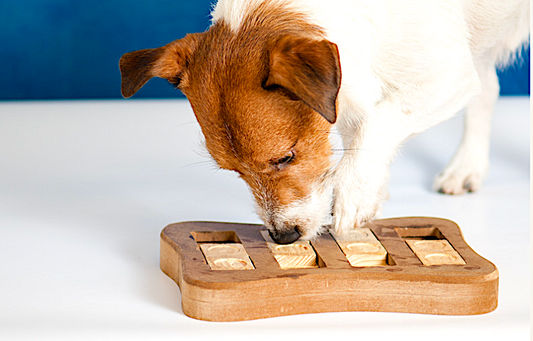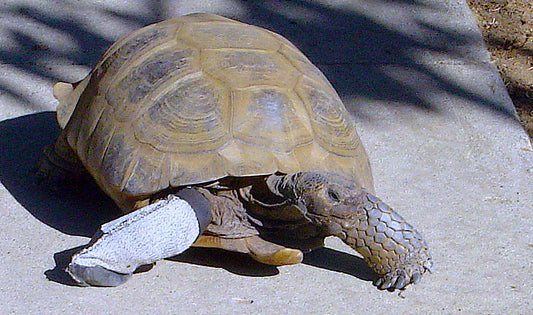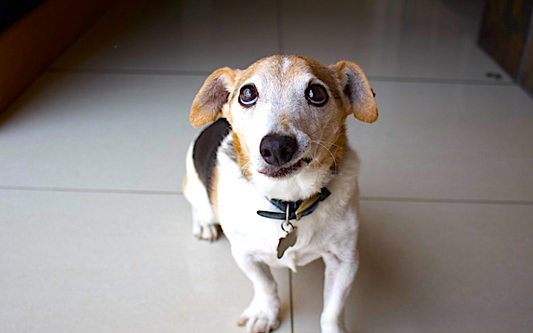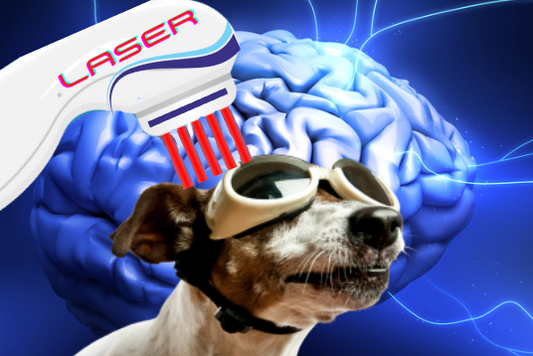The excerpt below is from an article by Drs. Gayle Jaeger and Sherman Canapp on carpal and tarsal injuries in dogs first seen in Clean Run Magazine in 2008. Though it's an older article, it is well-organized and still relevant.
Carpal (front leg wrist) and tarsal (back leg ankle) injuries are common in larger and more active dogs but can occur in any dog and breed. Canine athletes are more prone to these injuries because of the physical demands of their sport. Let's take a closer look at these injuries then discuss some wraps and braces that can be used to help with recovery.

Carpal and Tarsal Injuries
Injuries to the carpal and tarsal joints are common in performance dogs. These joints act as shock absorbers during weight bearing and are prone to injury due to their anatomic complexity and lack of muscular support. It is this complexity that creates a diagnostic problem for many veterinarians, and many carpal and tarsal injuries, particularly those that go undiagnosed or untreated, can result in an increased risk of osteoarthritis and potential long-term lameness.
Cause of Injury
Carpal and tarsal injuries can result from either acute traumatic events or activities that cause sudden repetitive sprains to the joints’ supportive structures. Possible modes of injury include hyperextension (the most common type seen in agility dogs), hyperflexion with rotation, varus (inside of the limb) or valgus (outside of the limb) injuries, degeneration of ligaments in some breeds (Collies and Shelties), and certain immune-mediated diseases such as rheumatoid arthritis.
Types of Injuries
Carpal and tarsal injuries can be classified into sprains, luxations, fractures, or a combination of the three.
Sprains are the most common injuries in performance dogs, and sprains to the carpal and tarsal joints are the most likely to go undiagnosed. A sprain is an injury to a ligament that can occur in the midportion of the ligament or at its attachment to bone. Sprains are graded by severity.
- Grade 1 sprains are mild and described as an overstretching of the ligament, without a tear or loss of function.
- Grade 2 sprains are moderate in severity and are described as a partial tear. The general continuity of the ligament is intact though its strength is significantly reduced.
- Grade 3 sprains are severe and involve complete disruption or tearing of the ligament, resulting in joint instability. Since ligaments have a poor blood supply and require the formation and organization of collagen (scar tissue) for their repair, ligament healing times can be quite lengthy. Ligaments only regain about 60% of their original strength after one year. If a gap forms or is present at the junction of the ligament ends during healing, permanent ligament elongation and subsequent instability may result, even if an intact ligament reforms.
Luxation, or dislocation, involves the disruption of multiple ligaments and the joint capsule. In the carpus, the antebrachiocarpal joint is the most common site of luxation due to its increased range of motion and its conformation. In the tarsus, however, the intertarsal joints are commonly affected due to the relative lack of bone interdigitation of these joints compared to the tibiotarsal joint, which serves as an inherent joint stabilizer.
Common fractures associated with carpal and tarsal injuries in performance dogs include the attachment sites for the collateral ligaments (avulsion fractures) or bone fractures due to compression or shear forces. Fractures at these sites result in joint instability when stressed on palpation or during weight bearing. Another fracture site is the accessory carpal bone in the front limb, where the flexor carpi ulnaris tendon attaches. A hyperextension injury can result in fracture of the accessory carpal bone where the tendon attaches, as well as damage to the palmar (underside) ligaments. Similarly, in the hind limb, fractures of the calcaneus (heel bone) can occur.
Treatment
Treatment is based on the location and severity of the injury.
Mild to moderate ligament sprains (Grades 1 and 2) are amenable to external support, using specialized wraps, orthotics, a splint, or a cast for six to eight weeks, in addition to rehabilitation therapy. Supportive bandages allow for joint immobilization, preventing further injury to the affected ligament and providing stability so the ligament can heal. Specialized support wraps and orthotics like those shown in Figure 5 can be custom designed and manufactured for each individual dog.
For more severe cases, an external fixator with a hinge can be placed above and below the injured joint. This allows the joint to heal, while at the same allowing controlled range of motion to strengthen the resulting repair. Unsupported or premature weight bearing during healing can result in an elongated ligament, negating the return of ligament strength and resulting in persistent instability. Nonsteroidal anti-inflammatory medications and cryotherapy (ice wraps) can be administered in the initial stages of the injury to improve comfort, reduce swelling, and facilitate overall limb use.
Severe sprains or luxations causing insta- bility (Grade 3) usually require surgery. Surgical options include primary repair of the torn ligament, the placement of a prosthetic ligament (suture) when primary repair cannot be performed, or a partial or complete arthrodesis (joint fusion).
Luxations of the middle carpal, metacar- palphalengeal joint, intertarsal or tarso- metatarsal joints, or disruption of the pal- mar or plantar ligaments can be stabilized with partial arthrodesis. This allows for stabilization of the joint while maintaining the majority of joint motion. When there is
instability of the antebrachiocarpal or tibio- tarsal joints, complete arthrodesis is usually necessary. Arthrodesis can be performed by long-term stabilization with an external skeletal fixator, plate and screws, or internal pins and wire. Surgical reconstruction or internal arthrodesis requires additional support from an external bandage for at least six weeks. Fractures warrant open sur- gical reduction and internal fixation (plate and screws or pins and screws). Internal fixation of fractures of the small bones of the carpi and tarsi can be difficult due to the small and irregular size of their bones.
Prevention
Although carpal and tarsal injuries may occur due to repetitive activity and recurrent sprains, a majority of these injuries occur out of the ring. Jumping down from high levels is one of the most common causes of severe injury. Therefore, this activity should be avoided whenever possible. Agility dogs with chronic carpal and tarsal injuries may benefit from a custom support wrap during practice and competition. Unfortunately, however, few agility organizations allow dogs to compete with support wraps.
Authors: Gayle H. Jaeger, DVM, MSpVM, DACVS and Sherman O. Canapp Jr., DVM, MS, DACVS Original Source
------------------------------------
As stated in this article, injuries that are mild or moderate can be effectively treated with wraps and braces. Though severe injuries might require surgery, some dogs may not be good candidates and for these dogs, braces can be a good alternative.
When thinking about what brace might be best for your dog, there are a few things to consider.
- A brace should provide the right amount of support - People might think that "more support is better" but too much support could lead to muscle wasting. Conversely, too little support might not stabilize the joint well enough for healing to take place.
- A brace should be form-fitting - A plastic pipe, like PVC, is very strong but if you slide it over a dog's leg, it won't support or brace the limb namely because it's not fitted or shaped to the leg. The more intimately-shaped (close-fitting) the brace is to the dog's leg, the better it will support healing structures. Also, the more close-fitting the wrap or brace, the less chance it has of sliding or spinning or causing abrasions.
- In general, a front leg brace should run between 1/2 to 3/4 of the way up the limb, from floor to elbow (see image below). 1/2-way up the limb will provide lighter support; 3/4-way up the limb will provide heavier support. When ordering a wrap or brace, it's important to measure the dog carefully.

Some Options for Wraps and Braces
Lightly-supportive, pre-made wraps are useful for
- tiny, small, and medium size dogs
- mild injuries, mild arthritis
- short-term use (during activity or for 1-3 weeks only)
Some lightly-supportive, pre-made wraps include:
- Carpo-Flex Sports Wraps (for front legs), Tarso-Flex Sports Wraps (for back legs) and Minis (for toy breeds) - all of these wraps can be trimmed as needed to provide an intimately-close fit
- Back On Track Leg Wraps (for front legs and back legs) - great for dogs with arthritic wrist or ankle joints who can benefit from a little heat therapy
- Labra Front Leg Wrap and Back Leg Wrap
If the wraps are fitted well to the pet, they can even be worn during high-intensity activities to protect dogs from injury and re-injury.
Moderately-supportive, pre-made braces are useful for
- small, medium, and large size dogs
- mild to moderate injuries or pain
- longer-term use (for daily wear or for 4-12 weeks)
Some moderately-supportive, pre-made braces include:
- Carpo-Flex-X (for front legs) and Minis (for tiny dogs) - these braces come with additional support stays and can be trimmed as needed to provide a more intimate and better fit
- DogLeggs carpal support and tarsal support
- Orthopets carpus wrap and tarsus wrap
Custom-made wraps and braces are useful for
- tiny dogs (where fragile, gentle care is needed)
- large and giant breeds (where more heavy-duty support is required)
- moderate-to-severe injuries or pain
- long-term use (8 weeks and up)
- dogs with deviations, deformities, skin issues, or other special considerations
custom-made carpal brace by Thera-Paw
Custom-made braces provide individual fit and support since they are made using the pet's specific size and requirements. They can be lined with memory foam or sheepskin to protect the leg. They can offer the right amount of support, protection and/or stability, and the support can be increased or decreased as needed. If interested in a custom-made carpal or tarsal brace, download this form to bring to your veterinary professional.
Custom-made orthotics (hard plastic splints with or without hinges) should also be considered for dogs with moderate-to-severe injuries and those that need long-term care. Custom orthotics companies can be found here.
Author: Ilaria Borghese, MS, MA, OT, Thera-Paw, Inc., STAAR Conference, Vital Vet
Other Related Publications
- Traction for Weak, Unstable, or Injured Pets
- Custom Bracing for Pets with Injuries
- The Role of Equipment in Conditioning
- Devices for Pets that Are Knuckling or Dragging
- Pet Video Consults with Rehab and Fitness Experts









1 comment
My 2+ year dog has front flippers like a dachshund. One of them causes pain and she holds it up when she stops walking. I am hoping to find front leg braces that I can slip over her flippers so she can walk better. What kind of brace should I get?